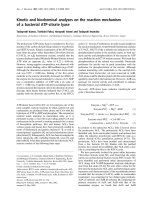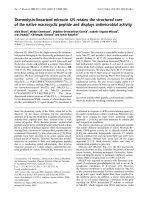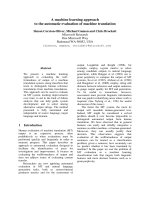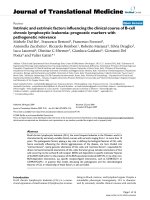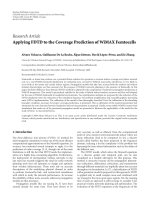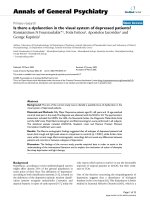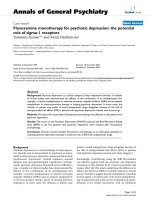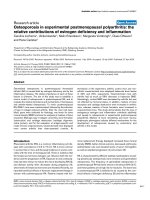Báo cáo y học: "HLA-C locus alleles may modulate the clinical expression of psoriatic arthritis" potx
Bạn đang xem bản rút gọn của tài liệu. Xem và tải ngay bản đầy đủ của tài liệu tại đây (92.65 KB, 5 trang )
Open Access
Available online />Page 1 of 5
(page number not for citation purposes)
Vol 8 No 6
Research article
HLA-C locus alleles may modulate the clinical expression of
psoriatic arthritis
Ruben Queiro
1
, Segundo Gonzalez
2
, Carlos López-Larrea
3
, Mercedes Alperi
1
,
Cristina Sarasqueta
4
, Jose Luis Riestra
1
and Javier Ballina
1
1
Rheumatology Service, Hospital Universitario Central de Asturias (HUCA), C/Celestino Villamil s/n. 33006, Oviedo, Spain
2
Department of Functional Biology, University of Oviedo, C/Julian Claveria s/n. 33006, Oviedo, Spain
3
Immunology Department, Hospital Universitario Central de Asturias (HUCA), C/Celestino Villamil s/n. 33006, Oviedo, Spain
4
Clinical Epidemiology Unit, Complejo Hospitalario Donostia, P° del Dr Beguiristain 111, 20014, San Sebastian, Basque Country, Spain
Corresponding author: Ruben Queiro,
Received: 15 Aug 2006 Revisions requested: 4 Sep 2006 Revisions received: 4 Nov 2006 Accepted: 13 Dec 2006 Published: 13 Dec 2006
Arthritis Research & Therapy 2006, 8:R185 (doi:10.1186/ar2097)
This article is online at: />© 2006 Queiro et al.; licensee BioMed Central Ltd.
This is an open access article distributed under the terms of the Creative Commons Attribution License ( />),
which permits unrestricted use, distribution, and reproduction in any medium, provided the original work is properly cited.
Abstract
The aim of the present study was to evaluate the relative
contribution of human leukocyte antigen (HLA)-C locus alleles in
determining the risk and the clinical expression of psoriatic
arthritis (PsA). One hundred PsA patients were randomly
selected and grouped into three disease subsets: oligoarthritis
(n = 40), polyarthritis (n = 25) and spondylitis (n = 35). The
HLA-C locus profile of this cohort was studied by methods
based on molecular biology and was compared with that of 45
patients with psoriasis vulgaris and 177 healthy blood donors
from the same ethnic origin. HLA-Cw*0602 was found
associated with both psoriasis (odds ratio (OR) 6.2; 95%
confidence interval (CI) 3.1 to 12.5; p < 0.0001) and PsA (OR
6.2; 95% CI 3.6 to 10.8; p < 0.0001); however, this allele was
equally found among the PsA subsets. HLA-Cw6-positive
patients showed a longer psoriasis-arthritis latency period (p =
0.012). HLA-Cw*0701 was found under-represented in PsA in
comparison with controls (OR 0.5; 95% CI 0.3 to 0.9; p = 0.04),
as was HLA-Cw*0802 (OR 0.3; 95% CI 0.08 to 1; p = 0.05). A
positive association was found between psoriatic spondylitis
and HLA-Cw*0702 (OR 5.0; 95% CI 1.4 to 25; p = 0.01). HLA-
Cw*0602 seems to confer a general risk for psoriasis, but the
presence of other HLA-C locus alleles may explain an additional
arthritogenic risk. HLA-C alleles may modulate some aspects of
the clinical expression of PsA, but these findings need
confirmation.
Introduction
It is thought that the development of psoriatic arthritis (PsA) is
related to an interaction between several genetic, immunolog-
ical and environmental elements, and there is now convincing
evidence to support this view [1].
Although the inheritance of psoriasis seems to be polygenic,
previous studies have localized the PSORS1 (psoriasis sus-
ceptibility 1 gene) locus to the proximal MHC (major histocom-
patibility complex) class I region. Approximately a dozen genes
in this region have so far been genetically inseparable, but very
recent studies suggest that among them, human leukocyte
antigen (HLA)-Cw6 itself is the true psoriasis gene [2,3]. In
addition, this gene is also relevant to modulation of the clinical
expression of psoriasis, as demonstrated by the fact that HLA-
Cw6-positive patients show an earlier disease onset and more
family aggregation than those without it [4].
Genetic factors are also important in both susceptibility to and
the expression of PsA; however, genetic association studies of
PsA are limited, among other factors, by its changing articular
pattern over time and the known phenomenon of linkage dise-
quilibrium between genes. The latter may explain why some
HLA genes originally associated with PsA susceptibility are
now being considered part of the ancestral haplotypes related
to psoriasis risk rather than true associations [5]. Moreover, it
has been difficult to discover whether HLA-Cw6 itself is asso-
ciated with PsA, because this is the primary marker for
CI = confidence interval; HLA = human leukocyte antigen; OR = odds ratio; PCR-SSOP = polymerase chain reaction-sequence-specific oligonucle-
otide probes; PsA = psoriatic arthritis; PSORS1 = psoriasis susceptibility 1 gene.
Arthritis Research & Therapy Vol 8 No 6 Queiro et al.
Page 2 of 5
(page number not for citation purposes)
psoriasis and most patients with PsA have cutaneous psoria-
sis; in contrast, some recent investigations have shown that
both conditions share a 100-kilobase susceptibility region tel-
omeric to HLA-C [6].
Few studies have investigated the potential role of HLA-C
locus alleles in the clinical expression of PsA, so this study was
undertaken to determine the relative contribution of HLA-C
alleles to psoriasis and PsA susceptibility, and as a subsidiary
purpose to evaluate whether these alleles confer some addi-
tional clinical feature on this disease.
Materials and methods
For the purposes of the present study, 100 PsA patients and
45 patients with chronic stable cutaneous psoriasis were con-
secutively recruited at random from the general database of
the rheumatology and dermatology departments of a tertiary
care hospital. In our health care context, psoriatic patients with
suspected arthritis are sent to our early arthritis clinic, where
they are further evaluated to confirm or rule out the diagnosis
of PsA. The PsA group was studied with a specific protocol
designed for this study, which included epidemiological and
demographic data, medical history, clinical features, physical
examination, laboratory data (including tests for rheumatoid
factor and antinuclear antibodies) and radiographs. Peripheral
and axial joints were evaluated with standard methods. All syn-
ovial fluid samples were cultured and analysed for crystals.
Pathogens that habitually cause arthritis were properly
excluded. The PsA group was initially defined and classified as
described in Moll and Wright's proposal [7] but, because of
the changing nature of PsA with time, patients were classified
in accordance with their predominant articular pattern seen in
the previous 5 years of disease evolution. Thus, patients with
four or fewer inflamed joints were labelled as having oligoar-
thritis; those with five or more swollen joints were defined as
having polyarthritis; and patients with inflammatory back pain
and bilateral grade II or unilateral grade III or more X-ray sacro-
iliitis were grouped as having spondylitis, irrespective of the
presence of peripheral synovitis. Distal interphalangeal joint
disease as well as mutilans forms were not computed as inde-
pendent models but rather as a characteristic of PsA.
We performed HLA-C typing in 145 patients (psoriasis and
arthritis) and in a control population of 177 random donors
from our general population. DNA was isolated from lym-
phocytes by standard procedures. HLA-C alleles were specif-
ically amplified with a combination of the sense primer SV1
(exon 2, codon 45) and the antisense primer SV2 (exon 3,
codon 182). The spanning sequences (680 base pairs) con-
taining the hypervariable regions of HLA-C exons 2 and 3 were
used to examine the HLA-C alleles. Polymerase chain reaction
conditions for the amplifications of exons 2 and 3 were 95°C
for 30 seconds and 67°C for 50 seconds (50 cycles), with a
initial denaturation step of 98°C for 1 minute and a final exten-
sion step of 70°C for 5 minutes. The specificity of the PCR-
SSOP (polymerase chain reaction-sequence-specific oligonu-
cleotide probes) method was checked by using B lymphoblas-
toid cell lines as positive controls for the HLA-C alleles.
The distribution of HLA-B27 antigen was also analysed in the
three groups of PsA.
The strength of the association between HLA-C/B27 antigens
and disease was calculated by odds ratio (OR), and the statis-
tical significance of these associations was assessed with a
two-tailed Fisher's exact test. To compare HLA-Cw6-positive
with HLA-Cw6-negative individuals, χ
2
and Student's t tests
were used to examine statistical differences, depending on the
type of variables analysed.
All patients were informed about the objectives of the study,
and informed consent sheets were obtained.
Results and discussion
The main characteristics of this series are shown in Table 1.
HLA-Cw*0602 was found to be associated with psoriasis (OR
6.2; 95% confidence interval (CI) 3.1 to 12.5; p < 0.0001)
and PsA (OR 6.2; 95% CI 3.6 to 10.8; p < 0.0001), but it was
equally distributed among the three articular categories
defined for the study. HLA-Cw*0602-positive individuals
showed an earlier age of psoriasis onset (23 ± 13 years) than
HLA-Cw*0602-negative patients (32 ± 14 years; p = 0.012).
The psoriasis-arthritis latency period was shorter in Cw6-neg-
ative patients (5 ± 5 years) than in Cw6-positive subjects (9 ±
7 years; p = 0.03). There were no other differences between
patients with and without this allele. HLA-Cw*0701 was found
under-represented in PsA (OR 0.5; 95% CI 0.3 to 0.9; p =
0.04), as well as in HLA-Cw*0802 (OR 0.3; 95% CI 0.08 to
1.00; p = 0.05). When we analysed the HLA-C antigen distri-
bution in the articular categories of PsA, a significant associa-
tion was found between the spondylitic form and HLA-
Cw*0702 (OR 5.0; 95% CI 1.4 to 25.0; p = 0.01). HLA-B27
was found more frequently in spondylitic patients (54%) than
in the groups with polyarthritis (12%) and oligoarthritis (20%)
(OR 5.8; 95% CI 2.3 to 14.7; p < 0.0001). Uveitis cases were
also more frequently found among spondylitic patients (OR
4.5; 95% CI 1.5 to 13.6; p = 0.006). Seventeen out of 100
patients had uveitis; of these, 10 showed the HLA-B27 anti-
gen (59%) (OR 4.5; 95% CI 1.5 to 13.4; p = 0.007). How-
ever, there was no correlation between HLA-Cw*0702 and
uveitis. Among PsA patients with spondylitis, those with iso-
lated forms had the HLA-B27 antigen (92%) more frequently
than those with oligoarthritis plus spondylitis (33%), and those
with polyarthritis-spondylitis (37%) (p = 0.003). HLA-
Cw*0702 was equally distributed between the three groups of
spondylitis. Tables 2 and 3 show the allelic distributions
between patients and controls, and between the articular sub-
types of PsA.
Available online />Page 3 of 5
(page number not for citation purposes)
Genetic factors have been considered to be important in stud-
ies of both susceptibility to and the expression of PsA. There
are at least nine psoriasis loci, designated PSORS1 to
PSORS9, and several potential loci, but the strongest associ-
ation is with a locus on chromosome 6p, probably the HLA-
Cw6 gene itself [2,3]. However, the pathogenic nature of
these associations remains elusive. Thus, it is not clear
whether HLA-Cw6 itself or a closely related gene is related to
the presence of arthritis in psoriasis patients, and few studies
have addressed this question so far. In a study by Gladman
and colleagues, the HLA-Cw*0602 allele was increased
among PsA patients, and these patients also showed an ear-
lier age of onset of their psoriasis [8]. Another study from
Poland had similar results, but also showed that patients
expressing this allele had an earlier age of onset of their arthri-
tis [9]. Nonetheless, both studies did not show whether these
associations were due to the presence of psoriasis in PsA
patients or, in contrast, whether it represented true associa-
tions with arthritis.
We performed HLA-C locus PCR-SSOP typing in both pso-
riasis and PsA patients and confirmed the known association
between HLA-Cw*0602 and both entities; however, when
articular subgroup comparisons were made, this allele was
equally distributed between them, supporting the notion that
genetic susceptibility to PsA resides in another gene. In this
sense, a potential arthritogenic polymorphism of MICA (major
histocompatibility complex class I chain-related gene A),
called MICA-A9, has been associated with PsA risk independ-
ently of HLA-Cw6 [10].
To test the hypothesis that HLA-Cw6 might modulate some
aspects of PsA in our context, we divided our PsA population
into PsA Cw6-positive and Cw6-negative patients. Our find-
ings confirmed that in Cw6-positive patients, psoriasis began
at an earlier age than in Cw6-negative patients. We also found
that the period between the onset of skin lesions and the
appearance of arthritis was longer in Cw6-positive than in
Cw6 negative-patients, but the arthritis onset age was similar
in both groups, probably reflecting that other genes are
responsible for arthritis onset; in that regard, the HLA-B27
antigen has been related to an earlier onset age for both pso-
riasis and arthritis in PsA [11].
Table 1
Clinical and demographic features of the study population
Variable PsA patients (n = 100)
Gender ratio (M/F) 55/45
Mean age (years) 52 ± 14
Psoriasis duration (years) 24 ± 9
Arthritis duration (years) 22 ± 8
Psoriasis onset age (years) 26 ± 14
Arthritis onset age (years) 35 ± 12
Psoriasis–arthritis latency (years) 8 ± 7
Psoriasis before arthritis (%) 75
Axial pattern (%) 35
Oligoarthritis (%) 40
Polyarthritis (%) 25
DIP disease (%) 40
Mutilans form (%) 4
Onychopathy (%) 45
Erosive disease (%) 44
Enthesitis (%) 35
Uveitis (%) 17
ESR 36 ± 12
RF (%)
a
7
ANA (%)
a
10
ANA, antinuclear antibodies; DIP, distal interphalangeal joint; ESR,
erythrocyte sedimentation rate; PsA, psoriatic arthritis; RF,
rheumatoid factor. Errors are shown as SD.
a
None of these patients
had rheumatoid arthritis or systemic lupus erythematosus.
Table 2
Allelic distribution of HLA-C in patients and controls
HLA-C allele Psoriasis (n = 45) PsA (n = 100) Controls (n = 177)
Cw*0102 5 (11) 10 (10) 13 (7)
Cw*0202 4 (9) 8 (8) 9 (5)
Cw*0303 3 (7) 11 (11) 19 (11)
Cw*0304 2 (4) 4 (4) 15 (8)
Cw*0401 7 (15) 23 (23) 50 (28)
Cw*0501 4 (9) 9 (9) 30 (17)
Cw*0602 26 (58)
a
58 (58)
b
32 (18)
Cw*0701 9 (20) 19 (19)
c
54 (31)
Cw*0702 7 (15) 17 (17) 45 (25)
Cw*0802 2 (4) 3 (3)
d
17 (10)
Cw*1203 3 (7) 3 (3) 6 (3)
Cw*1402 1 (2) 4 (4) 9 (5)
Cw*1502 4 (9) 5 (5) 13 (7)
Cw*1601 2 (4) 4 (4) 15 (8)
Cw*1602 - - 2 (1)
HLA, human leukocyte antigen; PsA, psoriatic arthritis. Results in
parentheses are percentages.
a
Odds ratio (OR) 6.2 (95%
confidence interval (CI) 3.1 to 12.5; p < 0.0001);
b
OR 6.2 (95% CI
3.6 to 10.8; p < 0.0001);
c
OR 0.5 (95% CI 0.3 to 0.9; p = 0.04);
d
OR 0.3 (95% CI 0.08 to 1.00; p = 0.05).
Arthritis Research & Therapy Vol 8 No 6 Queiro et al.
Page 4 of 5
(page number not for citation purposes)
An unexpected finding in the present study was the correlation
between HLA-Cw*0702 and spondylitis. This data had not
previously been reported and for that reason it deserves some
consideration. The first consideration is that psoriasis and PsA
show an overlapping interval of 100 kilobases between the
HLA-C and OTF3 regions, which might contain the psoriasis
gene, as well as arthritogenic genes including other alleles of
the HLA-C locus, besides HLA-Cw6 [6]. Secondly, psoriatic
spondylitis has been related to the presence of HLA-B27 in
several reports worldwide (including the present study) in
which this antigen might also be associated with some clinical
aspects of this entity [12]. In addition, some HLAB27/Cw
ancestral haplotypes may explain why some HLA-Cw antigens
are over-represented in spondyloarthropathies, including PsA.
According to this, the HLA-B*2705/Cw*0102, B*2705/
Cw*02022 and B*2702/Cw*02022 were the main haplo-
types found in normal and spondylitic patients in Spanish and
Jewish populations [13]. Indeed, the spondylitic form of PsA
was found in association with the HLA-B27/Cw1 haplotype in
a Spanish population [14]. As we have shown here, the HLA-
B27 antigen correlated well with the risk of uveitis and was
more strongly associated with isolated forms of spondylitis,
whereas HLA-Cw*0702 was not related to the presence of
uveitis and was distributed equally between the three sub-
groups of spondylitis.
For the above-mentioned reasons, we hypothesize that HLA-
Cw*0702 might be a new genetic risk factor for psoriatic
spondylitis, in addition to the known association between it
and the HLA-B27 antigen.
We found two HLA-Cw alleles under-represented in PsA
patients in comparison with controls. One of them, HLA-
Cw*0701, has been found as part of one of the ancestral hap-
lotypes associated with psoriasis (HLA-Cw7-B8-
DRB1*0301-DQB1*02) [15]. This finding supports our view
that the role of HLA-C locus alleles in determining the risk and
the clinical expression of both entities is not the same. Thus,
the HLA-Cw6 antigen seems to confer a general risk for pso-
riasis, whereas other HLA-C alleles may act as predisposing
factors for some subsets of PsA (HLA-Cw*0702 and spond-
ylitis), and others might be 'protective' alleles (HLA-Cw*0701/
Cw*0802). However, it should be borne in mind that some of
these statistical associations might be lost after correction for
multiple comparisons.
Conclusion
This is the first study to show a significant association
between HLA-Cw*0702 and psoriatic spondylitis, and this
relationship might have an additive effect with regard to the
presence of HLA-B27. The HLA-B27 antigen has a role in
determining the phenotype of psoriatic spondylitis, which is
not present in the HLA-Cw*0702 antigen. The potential role of
HLA-Cw*0701 and HLA-Cw*0802 as 'protective' alleles in
PsA should be accepted with caution, and further studies on
this subject are still necessary. In contrast, genetic association
studies like the present one might be hampered by the chang-
ing pattern of PsA over time, and the differences that could be
found in comparison with previous studies may be consistent
with the genetic distance between our population and other
ethnic groups. With this in mind, larger genetic studies should
be encouraged, so as to elucidate definitively the genetic
basis of psoriasis and its related arthropathy.
Competing interests
The authors declare that they have no competing interests.
Authors' contributions
SG reviewed the manuscript, the HLA typing and statistics,
and also contributed to the writing of the last version of this
manuscript. CLL reviewed the manuscript, the HLA typing and
contributed to the writing of the revised version of this work.
MA participated in the study design, the recruitment and eval-
uation of patients, and in the writing of the manuscript. CS per-
formed the statistical design of the study and participated in
the writing of the manuscript. JLR and JB participated in the
writing of the manuscript and performed patient evaluations.
All authors read and approved the final manuscript.
Table 3
Allelic distributions of HLA-B27 and HLA-C among subsets of
psoriatic arthritis
HLA Oligoarthritis
(n = 40)
Polyarthritis (n
= 25)
Axial disease
(n = 35)
Cw*0102 5 (12) 2 (8) 3 (9)
Cw*0202 3 (7) 2 (8) 3 (9)
Cw*0303 5 (12) 3 (12) 3 (9)
Cw*0304 2 (5) - 2 (6)
Cw*0401 12 (30) 5 (20) 6 (17)
Cw*0501 3 (7) 3 (12) 3 (9)
Cw*0602 23 (57) 15 (60) 20 (57)
Cw*0701 8 (20) 5 (20) 6 (17)
Cw*0702 3 (7) 3 (12) 11 (31)
a
Cw*0802 - 1 (4) 2 (6)
Cw*1203 2 (5) - 1 (3)
Cw*1402 2 (5) 1 (4) 1 (3)
Cw*1502 3 (7) 1 (4) 1 (3)
Cw*1601 3 (7) - 1 (3)
B27 8 (20) 3 (12) 19 (54)
b
HLA, human leukocyte antigen. Results in parentheses are
percentages.
a
Odds ratio (OR) 5.0 (95% confidence interval 1.4 to
25.0; p = 0.01);
b
OR 5.8 (95% confidence interval 2.3 to 14.7; p <
0.0001).
Available online />Page 5 of 5
(page number not for citation purposes)
References
1. Winchester R: Psoriatic arthritis and the spectrum of syn-
dromes related to the SAPHO (synovitis, acne, pustulosis,
hyperostosis, and osteitis) syndrome. Curr Opin Rheumatol
1999, 11:251-256.
2. Elder JT: PSORS1: linking genetics and immunology. J Invest
Dermatol 2006, 126:1205-1206.
3. Nair RP, Stuart PE, Nistor I, Hiremagalore R, Chia NV, Jenisch S,
Weichenthal M, Abecasis GR, Lim HW, Christophers E, et al.:
Sequence and haplotype analysis supports HLA-C as the pso-
riasis susceptibility 1 gene. Am J Hum Genet 2006,
78:827-851.
4. Schmitt-Egenolf M, Boehncke WH, Stander M, Eiermann TH,
Sterry W: Oligonucleotide typing reveals association of type I
psoriasis with HLA-DRB1*0701/2, -DQA1*0201-DQB1*0303
extended haplotype. J Invest Dermatol 1993, 100:749-752.
5. Degli Eposti MA, Leaver AL, Christiansen FT, Witt CS, Abraham
LJ, Dawkins RL: Ancestral haplotypes: conserved population
MHC haplotypes. Hum Immunol 1992, 34:242-252.
6. Martinez-Borra J, Gonzalez S, Santos-Juanes J, Sanchez del Rio J,
Torre-Alonso JC, Lopez-Vasquez A, Blanco-Gelaz MA, Lopez-Lar-
rea C: Psoriasis vulgaris and psoriatic arthritis share a 100 Kb
susceptibility region telomeric to HLA-C. Rheumatology 2003,
42:1089-1092.
7. Moll JM, Wright V: Psoriatic arthritis. Semin Arthritis Rheum
1973, 3:55-78.
8. Gladman DD, Cheung C, Ng CM, Wade JA: HLA-C locus alleles
in patients with psoriatic arthritis (PsA). Hum Immunol 1999,
60:259-261.
9. Szczerkowska Dobosz A, Rebala K, Szczerkowska Z, Nedoszytko
B: HLA-C locus alleles distribution in patients from northern
Poland with psoriatic arthritis: preliminary report. Int J
Immunogenet 2005, 32:389-391.
10. Gonzalez S, Martinez-Borra J, Torre-Alonso JC, Gonzalez-Roces S,
Sanchez del Rio J, Rodriguez-Perez A, Brautbar C, Lopez-Larrea
C: The MICA-A9 triplet repeat polymorphism in the transmem-
brane region confers additional susceptibility to the develop-
ment of psoriatic arthritis and is independent of the
association of Cw*0602 in psoriasis.
Arthritis Rheum 1999,
42:1010-1016.
11. Queiro R, Torre JC, Gonzalez S, Lopez-Larrea C, Tinture T, Lopez-
Lagunas I: HLA antigens may influence the age of onset of pso-
riasis and psoriatic arthritis. J Rheumatol 2003, 30:505-507.
12. Queiro R, Sarasqueta C, Belzunegui J, Gonzalez C, Figueroa M,
Torre-Alonso JC: Psoriatic spondyloarthropathy: a comparative
study between HLA-B27 positive and HLA-B27 negative
disease. Semin Arthritis Rheum 2002, 31:413-418.
13. Gonzalez-Roces S, Brautbar C, Pena M, Dominguez O, Coto E,
Alvarez V, Segal R, Lopez-Larrea C: Molecular analysis of HLA-
B27 haplotypes in Caucasoids. Frequencies of B27-Cw in Jew-
ish and Spanish populations. Hum Immunol 1994, 41:127-134.
14. Lopez Larrea C, Torre Alonso JC, Rodriguez Perez A, Coto E: HLA
antigens in psoriatic arthritis subtypes of a Spanish
population. Ann Rheum Dis 1990, 49:318-319.
15. Jenisch S, Westphal E, Nair RP, Stuart P, Voorhees JJ, Christo-
phers E, Kronke M, Elder JT, Henseler T: Linkage disequilibrium
analysis of familial psoriasis: identification of multiple dis-
ease-associated MHC haplotypes. Tissue Antigens 1999,
53:135-146.

